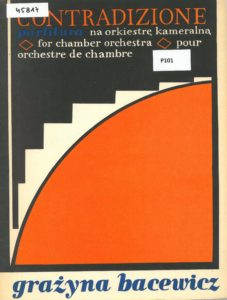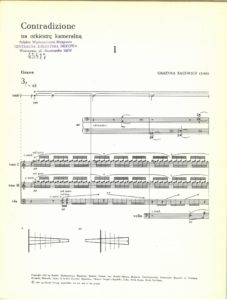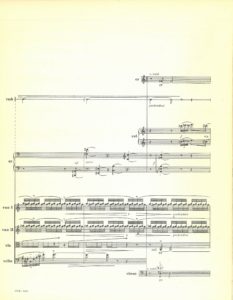In the programme booklet of the 1967 Warsaw Autumn International Festival of Contemporary Music Grażyna Bacewicz wrote:
Contradizione – a piece for 15-member chamber ensemble completed last December. The choice of the instruments was not accidental, for the fundamental element: juxtaposition of all kinds of musical contradictions (for example, ‘mismatched’ playing techniques), depended on the instruments used in the work. Obviously, the juxtaposition of contradictions was not an end in itself. The overriding goal was to create, out of these contradictory elements, a piece that would not only ‘withstand’ these juxtapositions of the musical material, but would also be able – thanks to its structure – to bind them together so closely that they would produce a fresh artistic experience as a result. The premiere of Contradizione – conducted by Mario di Bonaventura – took place on 16 July this year in Hanover (United States) at the Summer Festival of Contemporary Music organised by the Hopkins Center. Duration: ca 16 min. Movements: 1. Grave, 2. Acuto.
The orchestration in Contradizione is as follows: flute (changed to piccolo), oboe, clarinet in B flat, bassoon, horn in F, trumpet in C, percussion with two performers playing the tam-tam, cymbal, vibraphone, guiro, blocchi di legno, (soprano and bass) bongos, side drum (tamburo), bass kettledrum, celesta, harp, first and second violins, viola, cello and double bass. The score contains detailed instructions about how the instruments should be arranged on stage, presented in the form of a cone: with percussion instruments placed at the top; left side comprising, from top, harp, double bass and other strings, and the right side, from top – celesta, trumpet, and to the right of the conductor: horn and woodwind instruments.
Such a disposition was to highlight the intended sonic “contradictions”, which were the essence of the piece. This inevitably brings to mind Henryk Mikołaj Górecki’s Scontri from 1960 (Bacewicz thought very highly of her younger colleague’s early oeuvre), but the similarities do not end here. Written six years later, Bacewicz’s is a chamber piece and this implies major differences in sound distribution. In addition, Contradizione, unlike Scontri, is free from serial structuring. From the perspective of the composer’s earlier pieces, the idea of the work was to reject traditional narrative forms like motivic correspondence, evolutionism or thematic contrast in favour of a – synchronic or diachronic – catalogue-like juxtaposition of different sound situations or, like in the second movement, individual mobiles. These contradictions of sounds grow, as the title would have it, in the second movement – Acuto. Grave, on the other hand, is more continuous; successive sequences are characterised by a gradual expansion of the sound space and volume through the introduction of new instruments – sometimes treated as solo instruments – changes in texture and articulation, especially within the strings, which are particularly active in this part, bringing the action to a climax and gradually deactivating a given instrument group before changing the sound profile. Adrian Thomas describes the composer’s strategy in the first part as a kind of interaction between the various instruments and not a sound confrontation as would be suggested by Grażyny Bacewicz’s declaration. (Adrian Thomas, Bacewicz, Los Angeles 1985, p. 58).
The second movement is marked by a clear densification of action through quicker changes of sound situations in the form of short ostinatos, fleeting motifs, single strikes of, for example, the bongos against a background of fading strings, before a short harp glissando and three-bar trumpet trill, like in number 4. The melodic motif disappears completely – a group of notes sometimes forming a melodic line, for example, the clarinet solo against a violin spiccato and double bass pizzicato in number 13, is, given the specificity of the melodic line itself (the ambitus limited to a minor third), purely colouristic in nature. Similarly to the later four-bar solo of the first violin (first bar after number 24) against a harp tremolo. It is precisely the richness of colour and shimmering nature of the sound image that constitute the main asset of Contradizione.
- Contradizione, PWM score, cover
- Contradizione, PWM score, excerpt 1
- Contradizione, PWM score, excerpt 2


